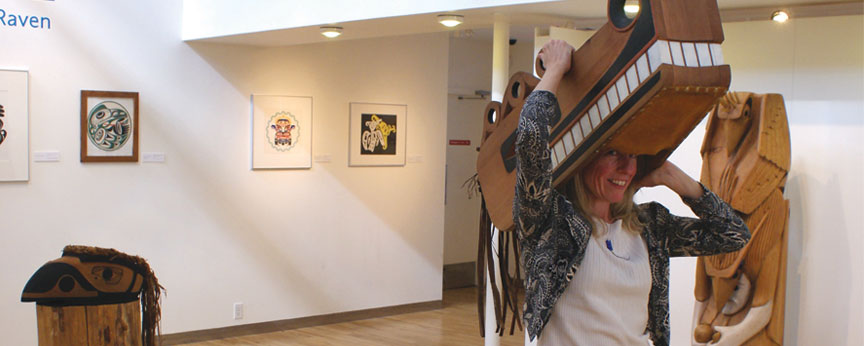Home / Continuing Studies News / Off the wall
Off the wall

with instructor Mary Jo Hughes
Mary Jo Hughes is the director of UVic’s Legacy Art Galleries, which consists of some 19,000 art objects. She has yet to personally handle all of them. The richness of UVic collections is constantly being accessed in creative ways to support the teaching and research that happens at the university. It also provides a lively and stimulating resource for the broader community.
With 25 years of experience working in art museums—a term Hughes prefers over galleries—she has seen accelerating changes in the way collections are displayed and used, and in the expectations of the people interacting with them from a professional or public perspective.
She sees our experience of the tangible artifacts being, more than ever before, a means of accessing the stories of the people behind them. Much of the distancing “preciousness” can be broken down in the crossover between gallery and museum with a non-static approach that really engages people.
A case in point is the collection that was on display at UVic’s Legacy Gallery when I visited Hughes. Many of the items were meant to be touched, handled, and even worn! It’s a little discomfiting at first, especially when dealing with objects drawn from aboriginal cultures. We have become more sensitized to the ritualistic and sacred meanings attached to such objects. Contemporary artists are opening our perspectives even further with new approaches. The works in the show (Emerging Through the Fog: Tsa-qwa-supp and Tlehpik – Together), created by two Nuu-chah-nulth men, “Fog-God” Art Thompson from Ditidaht (1948-2003) and Hjalmer Wenstob from Tla-o-qui-aht, includes interactive carvings.
Hughes says that the heritage/museum sector now involves more cultural sensitivity, more partnerships rather than perspectives based on authority, as well as active facilitation of dialogue about society and culture.
Hughes has redeveloped and will deliver an online course for Continuing Studies called Museum Principles and Practices. It’s part of the Continuing Studies Cultural Resource Management Program.
She finds it an exciting prospect to work with students who are early or mid-career professionals with different backgrounds.
On the lighter side, apart from hiking and painting on Galiano Island, Hughes is taking woodworking classes and speaks fondly of the newly acquired table saw waiting for her to start using. She has also tried paddle boarding and is an avid cyclist.
Victoria is great for that, she says, recalling her time as curator of historical art at the Art Gallery of Winnipeg where only four months of cycling was possible each year. Here, she can cycle from the downtown gallery to meetings at the University of Victoria campus through all seasons.
Hughes draws my attention to the tops of some trees across the street, just visible through her office window. “Look how beautiful the light is on them,” she says. “I wish people would stop and notice things more—that we could all be more mindful of the world around us."
This article was writen by MJ Turner and first published in the Fall 2016 Calendar.
- Posted July 28, 2016
RELATED TOPICS: Art HistoryIndigenous Language and Culture
Visit Registration
2nd Floor | Continuing Studies Building University of Victoria Campus 3800 Finnerty Road | Victoria BC | CanadaTel 250-472-4747 | Email uvcsreg@uvic.ca
2024 © Continuing Studies at UVic
Legal Notices |
Sitemap

